WWII GERMAN MOTHER'S CROSS -
The Mother's Cross (Cross of Honour to the German Mother) was a civilian award issued by the German
Government during WWII in an effort to thank and recognize mothers who had kids. The Reich understood the
importance of population. They knew that the only way they could accomplished their goals was if there
were enough people to carry on the tasks.
The award was created in 1938. There were three types of crosses. The design was very much the same except for
the color of the border of the cross and the starburst pattern.
This is a very attractive cross. The design consisted of widening blue enamel arms with a white border. A circle
was placed at the interception points of the arms. The circle had a white background with a black swastika. The
words "Der Deutschmen Mutter" were written around the perimeter of the circle, which translates to
"The Deutschmen mother". A long and narrow blue and white stripped ribbon was secured to the top of the cross.
The award was meant to be worn around the neck.

|
This page is a recognition and identification guide for WWII German badges and awards. Multiple
detailed photos of a specific sample are provided. Descriptions point out clearly defined points
that should be noted.
One of the most commonly asked questions is "How much is my WWII German badge worth?". A price
guide is included here to address this question. The value of the badges and awards is reviewed
over a period of several years. A trend can be observed. The present worth of the German
badges in the collector's market is illustrated.
This service is provided free of charge to the visitor/enthusiast courtesy of
MilitaryItems.com,
a company dedicated to the preservation of military history and to providing quality military
antiques and collectibles to museums, institutions and the general public.
|
|
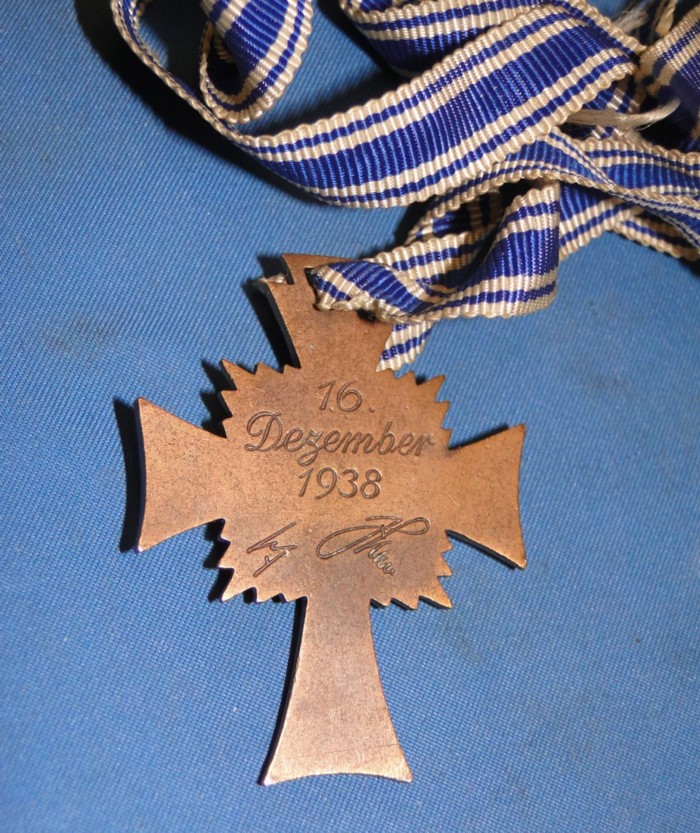
The back of the cross has a Flat and plain design. The date of "December 16, 1938" is engraved alomg with Hitler's
signature. The Mother's Cross was issued from 1938 all the way to 1945.
The Mother's Cross came in full size and as a miniature pin
which was manufactured in the same three classes available to the larger version.
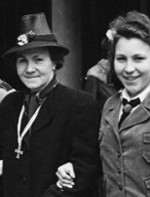
|
WE BUY German German civilian badges, medal and related items - All types of WWII German civilian awards. Whether it is for
fire department, police. civil defense or any other civilian organization.
The process gets started by you sending us an
Email .
We will respond to your inquiry normally within 24 hours and in many cases much faster.
We can tell you what you have, what it is worth and how much we can pay you.
One item or an entire collection -
Email Us .
|
 |
The idea for the creation of the pin version was that the person did not have to wear the bulky award around her neck but
could simply wear a pin on her lapel. The miniature version was not provided by the state. It had to be purchased by the
person on her own.
The above photo shows a mother proudly wearing the award around her neck as she walks flanked by her daughter.

| PICTURE |
CLASS |
CRITERIA |
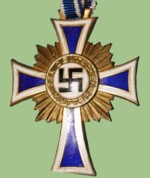 |
Bronze |
The Cross was issued to mothers who gave birth to Four children.
view example.
|
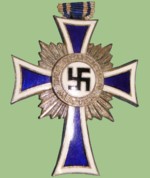 |
Silver |
This award was issued to the mother when she reached having Six Children.
view example.
|
 |
Gold |
This award was issued for having Eight Children.
view example.
|
|
Conditions and qualifications
The mother receiving the Mother's Cross award was required to meet a series of qualifying factors. The awards was issued
in three different classes based on the number of children the mother had.
| 1 |
Both, parents and children, are of German blood.
|
| 2 |
The mother is worthy (according to decency standards of the day).
|
| 3 |
The children are born alive.
|
|
Documentation and presentation
When the Mother's Cross was issued to a person it came with a case which was covered in a blue corynthian leather.
A hinge was placed at one end. A locking mechanism was located at the opposite end. A brass button protrudes from
the lock. Pressing it disengages the mechanism allowing the box to be opened.
A facsimile of the Mother's Crossed is placed at the top center of the lid of the box.
The inside of the box is divided into two compartments. One section is created for the flowing ribbon while the other houses
the cross itself. A divider separated the sections and has an opening to allow the ribbon to pass through.
The underside of the lid is lined with a white silky material
|
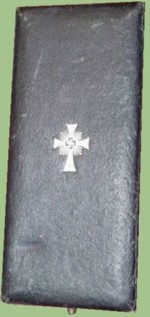
|
which is ample enough to hide the hinge from view. The name of the manufacturer may printed just above the hinge.
The base has a chamois lining.
|
By the Numbers
Trying to determine the number of Mother Crosses that were produced can be a tricky proposition.
medal factories maintained records of the exact number of crosses that were produced and issued to
mothers during the war. However, some of these records may have been lost or simply
never found after the war.
|
There were millions of Mother Crosses that were brought back home as souvenirs from the war.
The exact number may be impossible to determine brcause there are variables affecting the numbers.
|
For example, some soldiers took souvenirs and shipped them home circumbenting the established process.
Some of the helmets were brought back inside duffle bags without anyone knowing except for the soldier who
captured the cross. This fact would clearly affect the final count.
The number also does not account for crosses that were taken by Allied soldiers from other countries.
Collecting Mother Crosses
Collecting Mother Crosses is a field that has been growing since the days the GI's rummaged around Europe
bringing back military souvenirs. German soldiers carried many of these crosses when they went to
battle. Once the cities were taken, the Americans would take medals and awards as war trophies.
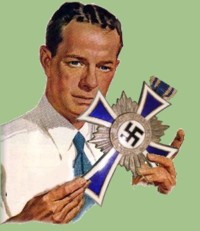 |
Eventually all these pieces came back to the United States where military history enthusiasts began to collect them.
In trying to determine if you should collect the Mother Cross there are certain factors that should be
considered.
The adjacent table outlines some of the advantages and disadvantages of collecting Mother Crosses.
|
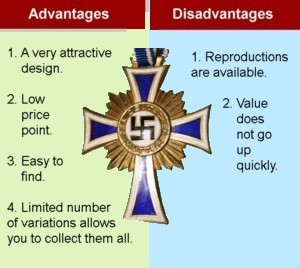 |
This award is currently being
reproduced.
It is becoming more difficult to be able to tell the fake ones from the real ones because the quality
of the reproductions is improving. The collector must become familiarized with the construction style
and materials employed in the manufacturing of this badge. Attention to the details is critical in
order to be able to determine the authenticity of the badge.
If you have an interest is seeing other badges and awards of the Third Reich, you can do so by going
to our
WWII German Badges and Awards
identification guide. Where we cover Heer (Army), Navy (Kriegsmarine) and
Air Force (Luftwaffe) items.
|







